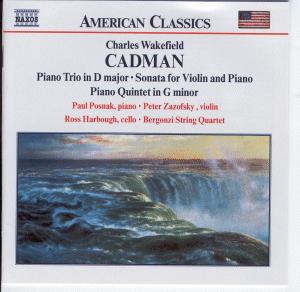Where will this Naxos series go next? Cadman is certainly
a recondite figure although, as hearing this disc will confirm, his
music is lyrically rewarding.
Cadman was of the Arthur Farwell Indianist camp. His
opera Shanewis, in which he used native Indian music, achieved
considerable success. He gave lecture recitals with the Indian mezzo
Tsianina Redfeather. However I detect little of that world in this music.
The contours of the Piano Trio suggest an allegiance
to searching Gallic lyricism. Here he stands at the confluence of the
Franckian stream on one side and the Brahms on the other. Saint-Saens
and Tchaikovsky are also presences. The music is florid and ecstatic
with the first movement gliding along like an athletic swan. Despite
some awkwardness in ensemble the music achieves a sanguine confidence
and loquacious flood. This is Elysian music - sentimental but for the
most part not cloying.
The Sonata is taken by Zazofksy a Bostonian who studied
with Joseph Silverstein. He is no stranger to esoterica having performed
the Busoni violin concerto with the BBCPO/Gunther Herbig on BBC radio
3 in 1982. He has a searching forward unacademic sound. The work inspired
by the Pacific coast and its desert hinterland was written in Fresno
in 1929 and premiered the next year. It reminded me of the Dunhill and
Ireland first sonatas. The skittery playfulness of Brahms Second Piano
Concerto in the first movement contrasts with the raindrop piano and
beguiling subtlety of the middle movement. Cadman obeyed dramatic convention
for the ending.
The Quintet is a noticeably more modern piece. It remains
strenuous but the textures are lighter - less Brahmsian in density and
of a lighter dancing quality. There is a Franckian striving for new
and passionate heights and a startlingly ominous dissonance at end of
first movement.
After such a start I have my fingers crossed that Cadman's
First Symphony will be next in the queue. Its premiere was treated to
an NBC broadcast on 15 March 1940. The composer was interviewed before
the performance and expressed his profound gratitude to the Los Angeles
Philharmonic and the conductor Albert Coates. He said that working with
the LAPO had been a very happy experience. The Symphony is in three
autobiographically programmatic movements portraying a fairground, factory
life and the struggle between labour and the bosses - resolved in optimism
rather than doom. The Symphony which I have heard in that Coates directed
premiere and also in the hands of Dan Winston Vogel directing the BBC
Concert Orchestra is vividly rustic - Cadman being excellent as the
poet-painter of the outdoors. The music has a Dvorakian swing and a
grandeur in the swirling high strings which appear in the first movement
and also open the finale. The music is wheezy and brusque - a whirl
of gaudy life fading into a tired sunset.
Until the entertaining First Symphony arrives on the
scene you can now through this inexpensive disc access the laid-back
and romantic world of Charles Cadman.
By the way is the cover a detail from the same Niagara
Falls portrait used for the Grofé orchetsral collection on Naxos?
Rob Barnett
A SELECT LIST OF OTHER WORKS BY CADMAN
Four American Indian Songs, for voice and piano (1907)
The Vision of Sir Launfal, cantata for female
voices and orchestra (1909) Pittsburgh
"At Dawning," for voice and piano (1911)
Daoma, opera (1912)
Idealized Indian Themes, piano suite (1912)
To a Vanishing Race, for string orchestra or
full orchestra, originally for piano (1913)
Piano Trio {1914)
The Garden of Mystery, one-act opera (1915)
f.p. 20 March 1925, NY
Thunderbird, suite for orchestra (1916) 9 Jan
1917, Los Angeles
Shanewis, (The Trobin Woman) opera (1917) f.p.
23 March 1918, The Met
String Quartet (1917)
Oriental Rhapsody from Omar Khayyam, for orchestra
(1921)
The Sunset Trail, operatic cantata (1922) f.p.
5 Dec 1922, Denver
A Witch of Salem, opera (1925) f.p. 8 Dec 1926,
Chocago
The Willow Tree, radio opera (1925) fbp NBC
3 Oct 1933
The Father of Waters, for mixed voices (1928)
Hollywood Suite, for orchestra (1932)
Dark Dancers of the Mardi Gras, for orchestra
(1933)
American Suite, for strings, also for full orchestra
(1937)
Sonata in G, for violin and piano (1937)
Symphony, Pennsylvania (1939)
Aurora Borealis, fantasy for piano and orchestra
(1942):
A Mad Empress Remembers, tone drama for cello
and orchestra (1944)
Huckleberry Finn Goes Fishing, an "American
overture" (1945).


